2020年(交通运输)集装箱运输与多式联运
我国集装箱多式联运的现状与趋势

•我国集装箱多式联运的现状与趋势•交通运输的迅猛发展给社会带来了便利的同时,也带来了能源问题、环境问题,以及交通拥挤等社会问题,更不要说在当下油价飞涨的情况下。
因而,如何发展我国国际集装箱多式联运,不仅是我国经济发展的迫切需要,对我国加入世界经济大循环更具有重要意义,而且对解决上述问题有着不可或缺的积极意义。
在不久前召开的第四届中国国际集装箱多式联运发展论坛上,一些部门领导和有关专家对我国集装箱多式联运的现状、存在问题和发展前景做了客观而中肯的论述。
本刊记者随机采访并撷取了一些专家的论述组成这期话题;主持人语:始于1978年的我国集装箱多式联运,是同我国的改革开放步伐一起发展起来的。
三十年来,在运输变化、能源变化、全球经济形势变化及我国物流形势的发展变化中,我国的集装箱多式联运能不能满足国民经济发展的需要?它的现今状况又如何呢?王明志:我国海运集装箱运输从1978年起步以来发展迅速,已经取得了举世瞩目的辉煌业绩。
连续20年保持30%以上的增幅,连续30年保持23%以上的增幅。
尤其是近几年的发展更为迅猛,不断出现重大突破。
2002年,我国港口集装箱吞吐量已经突破了3700万箱,成为世界第一;2007年,全国港口集装箱吞吐量突破亿箱,达到11270万标准箱,5年几乎翻两番,构成了全国港口集装箱运输总量在世界遥遥领先的态势;特别是在全球20大集装箱港口排名里面,2007年我国有8个港口,其中大陆占了6个,分别是上海、深圳、青岛、宁波舟山、广州、天津。
其中,上海港集装箱吞吐量首次超过香港成为世界第二。
2003年以来,我国港口集装箱装卸效率不断刷新和突破世界记录,目前也一直保持着世界领先水平。
在世界航运市场上,中国因素已经成为举世公认的重要因素,对于国际海运贸易的健康发展、维系国际航运市场经济秩序起着十分重要的作用。
可以说,我国参与国际海运事务,参与制定国际规则和政策的深度和广度都在不断加强。
我国水运在国际集装箱运输领域取得的成绩,归功于国家改革开放,归功于国家经济的快速发展,同样归功于全国交通系统和各级政府部门的科学决策,归功于广大干部职工的共同努力。
集装箱运输与多式联运(重点内容)
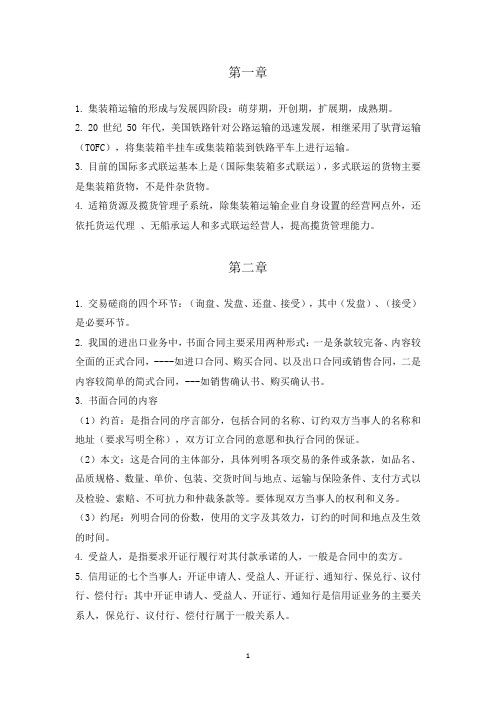
第一章1.集装箱运输的形成与发展四阶段:萌芽期,开创期,扩展期,成熟期。
2.20世纪50年代,美国铁路针对公路运输的迅速发展,相继采用了驮背运输(TOFC),将集装箱半挂车或集装箱装到铁路平车上进行运输。
3.目前的国际多式联运基本上是(国际集装箱多式联运),多式联运的货物主要是集装箱货物,不是件杂货物。
4.适箱货源及揽货管理子系统,除集装箱运输企业自身设置的经营网点外,还依托货运代理、无船承运人和多式联运经营人,提高揽货管理能力。
第二章1.交易磋商的四个环节:(询盘、发盘、还盘、接受),其中(发盘)、(接受)是必要环节。
2.我国的进出口业务中,书面合同主要采用两种形式:一是条款较完备、内容较全面的正式合同,----如进口合同、购买合同、以及出口合同或销售合同,二是内容较简单的简式合同,---如销售确认书、购买确认书。
3.书面合同的内容(1)约首:是指合同的序言部分,包括合同的名称、订约双方当事人的名称和地址(要求写明全称),双方订立合同的意愿和执行合同的保证。
(2)本文:这是合同的主体部分,具体列明各项交易的条件或条款,如品名、品质规格、数量、单价、包装、交货时间与地点、运输与保险条件、支付方式以及检验、索赔、不可抗力和仲裁条款等。
要体现双方当事人的权利和义务。
(3)约尾:列明合同的份数,使用的文字及其效力,订约的时间和地点及生效的时间。
4.受益人,是指要求开证行履行对其付款承诺的人,一般是合同中的卖方。
5.信用证的七个当事人:开证申请人、受益人、开证行、通知行、保兑行、议付行、偿付行;其中开证申请人、受益人、开证行、通知行是信用证业务的主要关系人,保兑行、议付行、偿付行属于一般关系人。
6.FOB是离岸价,如果双方希望由卖方办理进口清关的所有手续并支付进口税费,则应当使用(DDP)。
第三章1.宽度为8 ft(2438mm),高度为8.6 ft(2591mm) 的20英尺杂货箱为国际标准集装箱;高度为10.5ft和宽度为12.75ft的双层汽车集装箱不是国际标准集装箱。
集装箱运输管理与多式联运习题答案-习题答案六

集装箱运输管理与多式联运习题答案-习题答案六第六章⼀、简答题1.简述集装箱货运站的分类及功能。
⽬前,集装箱货运站主要有两种类型,即集装箱码头货运站和集装箱内陆货运站。
集装箱码头货运站的主要功能包括以下7个⽅⾯。
(1)集装箱货物的承运、验收、保管和交付,包括出⼝拼箱货的积载与装箱、进⼝拼箱集装箱的拆箱与保管;(2)对库存的货物进⾏堆存保管及有关统计管理;(3)重箱和空箱的堆存与保管,整箱货的中转;(4)货运单证的交接及签证处理;(5)运费、堆场费的结算;(6)集装箱的检验、修理、清洗、熏蒸的业务,集装箱车辆的维修与保养;(7)其他服务,如为办理海关⼿续提供条件、代办海关业务等。
集装箱内陆货运站除具备码头货运站的基本功能外,还必须负责接受托运⼈托运的整箱货及暂存、装车并集中组织向码头堆场的运输或集中组织港⼝码头向该货运站的疏运及交付;接收各类箱主的委托承担集装箱代理业务,对集装箱及集装箱设备的使⽤、租⽤、调运、保管、回收、交接等进⾏的管理。
2.简述集装箱货运站的业务流程。
进⼝:拼箱货由集装箱运站从码头堆场领取后,在货运站拆箱,并按提单分类,将货物交给前来提货的收货⼈,集装箱货运站主要的进⼝货运业务有以下6个⽅⾯。
1.做好交货准备2.发出交货通知3.从码头堆场领取载货的集装箱4.拆箱交货5.有关费⽤收取6.制作交货报告和未交货报告出⼝:集装箱货运站有两种类型,⼀种叫内陆港⼝型,另⼀种叫货源集散型。
集装箱货运站的主要业务有:办理货物交接、积载装箱、制作装箱单以及将装载的货箱运⾄码头堆场。
3.简述集装箱货运进出⼝的业务流程。
进⼝:(1)买⽅银⾏接受单证:买⽅所在银⾏收到卖⽅所在地区银⾏寄来的提单后,通知收货⼈前来结汇。
(2)付款取单:在收到银⾏结汇后,收货⼈在信⽤证贸易下应及时向银⾏付清所有的款项后,取得正本提单等有关单证。
(3)换取提货单:收货⼈凭正本提单及到货通知单向承运⼈或其代理换取提货单并付清相关费⽤。
多式联运贸易术语

多式联运贸易术语多式联运是指利用不同的交通方式(如铁路、公路、航空等)进行货物运输的一种物流方式。
在多式联运中,涉及到了一些专业术语,下面将对其中一些常用术语进行详细介绍。
1. 多式联运多式联运是指将不同交通方式有机结合起来,通过运输组织者的协调,实现货物的连续运输,提高运输效率和降低运输成本的一种物流方式。
多式联运可以通过不同的交通方式的组合,选择最佳的运输方案,实现货物的快速、安全、便捷的运输。
2. 集装箱运输集装箱运输是指将货物装入集装箱中,利用集装箱的标准尺寸和结构,通过不同的交通方式进行运输的一种方式。
集装箱运输具有装卸方便、运输安全、运输效率高等优点,是多式联运中常用的一种运输方式。
3. 整合运输整合运输是指将不同的运输方式有机结合起来,通过运输组织者的协调管理,实现货物的连续运输的一种方式。
在整合运输中,货物经过不同的运输方式的转运,通过统一的运输组织和管理,实现货物的快速、安全、高效运输。
4. 中转站中转站是指在货物运输过程中,货物需要由一种交通方式转运到另一种交通方式时,在转运过程中暂时存放货物的地方。
中转站通常设有相应的设施和设备,用于货物的装卸、仓储和转运,保证货物在转运过程中的安全和顺利进行。
5. 联运单据联运单据是指在多式联运中使用的各种单据,用于记录货物的运输情况和相关的信息。
联运单据包括运输合同、提单、装箱单、运单等,用于确保货物在多式联运过程中的合法性和安全性,方便货物的跟踪和管理。
6. 舱单舱单是指在海运中使用的一种单据,记录了货物的装船情况和相关的信息。
舱单包括货物的数量、重量、尺寸、包装方式等信息,用于确保货物在海运过程中的安全和顺利进行。
7. 清关清关是指货物从一个国家进入另一个国家时,需要经过海关的检查和审批的一种程序。
在多式联运中,货物通常需要经过多个国家的海关,进行出口和进口的手续办理和货物的检查和审批,确保货物的合法性和安全性。
8. 货运保险货运保险是指在多式联运中为货物提供保险保障的一种保险方式。
集装箱运输管理与多式联运习题答案-习题答案十二

一、简答题1.简述《海牙规则》的主要内容。
1.承运人最低限度的义务所谓承运人最低限度义务,即承运人必须履行的基本义务。
对此《海牙规则》第三条第一款规定:“承运人必须在开航前和开航当时,谨慎处理,使航船处于适航状态,妥善配备合格船员,装备船舶和配备供应品;使货舱、冷藏舱和该船其他载货处所能适当而安全地接受、载运和保管货物。
”该条第二款规定:“承运人应妥善地和谨慎地装载、操作、积载、运送、保管、照料与卸载。
”即提供适航船舶,妥善管理货物,否则将承担赔偿责任。
2.承运人运输货物的责任期间所谓承运人的责任期间,是指承运人对货物运送负责的期限。
按照《海牙规则》第一条“货物运输”的定义,货物运输的期间为从货物装上船至卸完船为止的期间。
所谓“装上船起至卸完船止”可分为两种情况:一是在使用船上吊杆装卸货物时,装货时货物挂上船舶吊杆的吊钩时起至卸货时货物脱离吊钩时为止,即“钩至钩”期间;二是使用岸上起重机装卸,则以货物越过船舷为界,即“舷至舷”期间承运人应对货物负责。
至于货物装船以前,即承运人在码头仓库接管货物至装上船这一段期间,以及货物卸船后到向收货人交付货物这一段时间,按《海牙规则》第七条规定,可由承运人与托运人就承运人在上述两段发生的货物灭失或损坏所应承担的责任和义务订立任何协议、规定、条件、保留或免责条款。
3.承运人的赔偿责任限额承运人的赔偿责任限额是指对承运人不能免责的原因造成的货物灭失或损坏,通过规定单位最高赔偿额的方式,将其赔偿责任限制在一定的范围内。
这一制度实际上是对承运人造成货物灭失或损害的赔偿责任的部分免除,充分体现了对承运人利益的维护。
《海牙规则》第四条第五款规定:“不论承运人或船舶,在任何情况下,对货物或与货物有关的灭失或损坏,每件或每单位超过100英镑或与其等值的其他货币时,任意情况下都不负责;但托运人于装货前已就该项货物的性质和价值提出声明,并已在提单中注明的,不在此限。
”承运人单位最高赔偿额为100英镑,按照该规则第九条的规定应为100金英镑。
中国集装箱行业与多式联运发展报告(一)

中国集装箱行业与多式联运发展报告(一)中国集装箱行业与多式联运发展报告一、背景介绍•集装箱运输的重要性•中国集装箱行业的发展二、中国集装箱行业现状•行业规模扩大–近年来的发展趋势–数据统计与分析•主要港口的发展–中国主要海港介绍–港口的运输能力与效率–港口网络的建设与改进•企业竞争与市场格局–企业竞争力分析–市场份额与市场动态–主要企业的发展策略三、多式联运的概念与意义•定义与特点•多式联运的优势与价值•多式联运与集装箱运输的关联四、多式联运发展现状•我国多式联运政策与战略•多式联运网络的建设与运营•成功案例分享五、挑战与展望•面临的挑战与问题•未来发展方向与趋势•推动多式联运的政策与措施六、总结•中国集装箱行业的发展概况•多式联运的意义与前景以上是《中国集装箱行业与多式联运发展报告》的相关内容概括。
通过该报告的介绍,我们可以了解到中国集装箱行业的现状以及多式联运的发展趋势,为相关行业提供参考和指导。
随着中国经济的快速发展,集装箱行业和多式联运将扮演更为重要的角色,为物流行业的进一步发展做出贡献。
七、背景介绍集装箱运输是现代物流运输的重要组成部分,其高效、便捷的特点使得集装箱运输成为全球贸易的主要方式之一。
中国作为全球最大的贸易国之一,集装箱行业在中国的发展具有重要的战略意义。
近年来,中国集装箱行业迅速扩大,为中国经济的增长和国际贸易的发展提供了强有力的支持。
八、中国集装箱行业现状1.行业规模扩大–近年来,中国的集装箱吞吐量不断增加,规模不断扩大。
–数据统计显示,中国的集装箱运输量位居全球前列,占据着重要的地位。
2.主要港口的发展–中国拥有众多重要的海港,如上海、深圳、天津等,这些港口的发展也直接影响着整个行业的发展。
–中国港口的运输能力和效率不断提升,提高了集装箱的装卸速度和运输效率。
–同时,中国还加大了对港口网络的建设和改进,进一步完善了集装箱运输的服务体系。
3.企业竞争与市场格局–中国的集装箱行业竞争激烈,企业之间的竞争力不断提高。
集装箱运输与多式联运课程设计

《集装箱运输与多式联运》课程设计目录1运输基本情况 (2)1.1运输作业 (2)1.2发货公司简介 (2)1.2.1发货人名称 (2)1.2.2公司简介 (2)2运输工具及路线选择 (2)2.1供选择的方案 (2)2.2方案分析与选择 (3)3运输合作伙伴选择 (3)3.1承运人名称 (3)3.2对运输方案的修改 (3)4运输单证及办理部门 (4)4.1主要运输单证 (4)4.2涉及部门 (4)5运输作业流程 (5)6运输费用计算 (5)参考文献 (6)附件1:国际货协铁路运单 (7)附件2:公路货物托运单 (8)附件3:货物清单 (8)附件4:货物装车单 (9)附件5:货物接收单 (9)附件6:报关单 (10)1运输基本情况1.1运输作业江西九江优元商贸有限公司运输20吨庐山云雾茶给德国PAPER&TEA茶叶公司。
1.2发货公司简介1.2.1发货人名称江西九江优元商贸有限公司1.2.2公司简介九江优元商贸有限公司座落于中国魅力城市--九江,是一家专业从事名优特产和天然绿色食品的商贸公司,主营休闲食品九江茶饼、南酸枣糕、湖口酒糟鱼、九江酥糖、三清山葛粉、婺源茶粉、庐山云雾茶、庐山石鱼、山茶油、炒货等。
本公司实力雄厚,重信用、守合同,保证产品质量,以多品种经营特色和薄利多销的原则,赢得了广大客户的信任。
公司秉承“顾客至上,锐意进取”的经营理念,坚持“客户第一”的原则为广大客户提供优质的服务。
由于我国有历史悠久的茶文化,所以我选择茶叶这一产品出口。
2运输工具及路线选择2.1供选择的方案从产地江西到收地柏林主要有两种可行运输方案:①从江西使用公路运输到上海,然后从上海使用航空运输到柏林。
②从江西使用公路运输到连云港,然后从连云港使用铁路通过第二欧亚大陆桥运输到柏林。
③从江西使用公路运输到上海,从上海使用海运到汉堡港,从汉堡使用公路运输到柏林。
2.2方案分析与选择①从承运人和装卸次数的角度来看,(1)和(2)的承运人数比(3)要少,换装次数也比(3)少,因此在这个角度上方案(1)和方案(2)优于方案(3)。
集装箱运输与多式联运

1.2集装箱多式联运的特征
国际集装箱多式联运是运输货物从一国(地区)到另一国(地区)之间的“位移”风险。由于所承保的保险标的在整个运输过程中,无论是地理位置,还是运输工具以及操作人员等均频繁变更,使得承保标的时刻暴露在众多的自然或人为的风险之中,因此与其他财产保险相比,多式联运运输保险有着下列不同的特征。
2.2存在的问题
我国集装箱多式联运的发展状况形势喜人。但据我们所知,目前我国集装箱多式联运发展还并不完善,在某些方面还存在着一些不尽如人意的问题,如在海铁联运方面,铁路的运量还不能满足港口运输的要求等等。
我国的集装箱多式联运尽管发展很快,但是2007年中国集装箱发送量仍然仅占铁路总货物发送量的2.3%,远远低于发达国家铁路占30%~50%的水平。但我想随着铁路紧张的逐步缓解,集装箱的多式联运发展将有更大的发展空间,集装箱多式联运会更加完善。目前,中国铁路正逐步形成以18个集装箱物流中心,40个专门办理站构成的现代化程度高,学习能力强的集装箱场站部,规划的18个物流中心部分已经投入运营,重庆、郑州、青岛、大连、成都等5个物流中心已经开工建设,武汉、西安物流中心开工在即,其它物流中心的建设正在积极推动。此外,我们还将稳步推进双集装箱的网络建设,京沪等铁路线路已经具备开设条件,并且市场前景广阔。
第四章我国国际集装箱多式联运发展应采取的策略
参考文献
摘要
集装箱运输是交通运输现代化的产物,是物流现代化的重要组成部分,集装箱多式联运是集装箱运输发展的高级形式,它以集装箱为运输单元,将不同的运输方式有机的组合在一起,构成连续的、综合性的一体化货物运输。通过一次托运、一次计费、一份单证、一次保险,由各运输段的承运人共同完成货物的全程运输。随着世界经济全球化发展、各国经济贸易国际化水平的普遍提高以及工业社会向知识经济时代的转型,可以预计,不仅外贸运输,而且连同内贸运输一起都将跨入集装箱多式联运的行列之中,集装箱多式联运主导综合物流活动的时代已经到来。从集装箱运输的发展,论述到集装箱运输与国际多式联运的关系,并进一步阐明了国际多式联运的优势及对全球贸易的重要性,但是由于技术方面的原因,存在不同国家对集装箱运输有着不同的海关制度原因,集装箱运输和国际多式联运也存在一些障碍,这些阻碍尚需要一定的时间和措施来扫除。
2020年交通运输行业发展统计公报

2020年交通运输行业发展统计公报交通运输部2020年,交通运输行业在以习近平同志为核心的党中央坚强领导下,全面贯彻党的十九大和十九届二中、三中、四中、五中全会精神,坚持稳中求进工作总基调,立足新发展阶段,贯彻新发展理念,构建新发展格局,以推动高质量发展为主题,以深化供给侧结构性改革为主线,统筹推进疫情防控和经济社会发展交通运输各项工作,加快建设交通强国,为扎实做好“六稳”工作、全面落实“六保”任务,如期实现全面建成小康社会目标提供了坚强的交通运输保障。
一、基础设施(一)铁路。
年末全国铁路营业里程14.6万公里,比上年末增长5.3%,其中高铁营业里程3.8万公里。
铁路复线率为59.5%,电化率为72.8%。
全国铁路路网密度152.3公里/万平方公里,增加6.8公里/万平方公里。
(二)公路。
年末全国公路总里程519.81万公里,比上年末增加18.56万公里。
公路密度54.15公里/百平方公里,增加1.94公里/百平方公里。
公路养护里程514.40万公里,占公路总里程99.0%。
年末全国四级及以上等级公路里程494.45万公里,比上年末增加24.58万公里,占公路总里程比重为95.1%,提高1.4个百分点。
二级及以上等级公路里程70.24万公里,增加3.04万公里,占公路总里程比重为13.5%,提高0.1个百分点。
高速公路里程16.10万公里,增加1.14万公里;高速公路车道里程72.31万公里,增加5.36万公里。
国家高速公路里程11.30万公里,增加0.44万公里。
年末国道里程37.07万公里,省道里程38.27万公里。
农村公路里程438.23万公里,其中县道里程66.14万公里、乡道里程123.85万公里、村道里程248.24万公里。
年末全国公路桥梁91.28万座、6628.55万延米,比上年末分别增加3.45万座、565.10万延米,其中特大桥梁6444座、1162.97万延米,大桥119935座、3277.77万延米。
《国际集装箱运输与多式联运》复习思考题和案例题解答
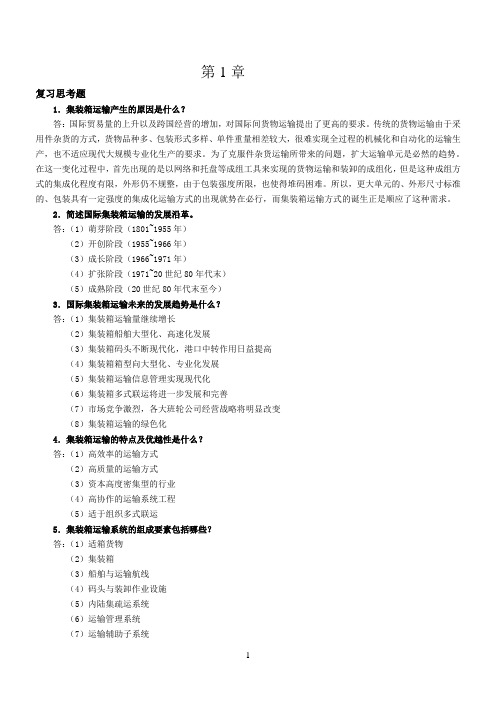
第1章复习思考题1.集装箱运输产生的原因是什么?答:国际贸易量的上升以及跨国经营的增加,对国际间货物运输提出了更高的要求。
传统的货物运输由于采用件杂货的方式,货物品种多、包装形式多样、单件重量相差较大,很难实现全过程的机械化和自动化的运输生产,也不适应现代大规模专业化生产的要求。
为了克服件杂货运输所带来的问题,扩大运输单元是必然的趋势。
在这一变化过程中,首先出现的是以网络和托盘等成组工具来实现的货物运输和装卸的成组化,但是这种成组方式的集成化程度有限,外形仍不规整,由于包装强度所限,也使得堆码困难。
所以,更大单元的、外形尺寸标准的、包装具有一定强度的集成化运输方式的出现就势在必行,而集装箱运输方式的诞生正是顺应了这种需求。
2.简述国际集装箱运输的发展沿革。
答:(1)萌芽阶段(1801~1955年)(2)开创阶段(1955~1966年)(3)成长阶段(1966~1971年)(4)扩张阶段(1971~20世纪80年代末)(5)成熟阶段(20世纪80年代末至今)3.国际集装箱运输未来的发展趋势是什么?答:(1)集装箱运输量继续增长(2)集装箱船舶大型化、高速化发展(3)集装箱码头不断现代化,港口中转作用日益提高(4)集装箱箱型向大型化、专业化发展(5)集装箱运输信息管理实现现代化(6)集装箱多式联运将进一步发展和完善(7)市场竞争激烈,各大班轮公司经营战略将明显改变(8)集装箱运输的绿色化4.集装箱运输的特点及优越性是什么?答:(1)高效率的运输方式(2)高质量的运输方式(3)资本高度密集型的行业(4)高协作的运输系统工程(5)适于组织多式联运5.集装箱运输系统的组成要素包括哪些?答:(1)适箱货物(2)集装箱(3)船舶与运输航线(4)码头与装卸作业设施(5)内陆集疏运系统(6)运输管理系统(7)运输辅助子系统6.国际集装箱运输信息系统体系包括哪些内容?答:国际集装箱运输信息管理体系结构图7.集装箱运输信息系统的基本功能是什么?答:采集、存储、分析、处理及传递与集装箱运输有关的各类信息,及时、准确地掌握集装箱运输的基本情况,向有关管理机构、运输企业和相关部门机构提供可靠的信息,为统计分析、运行组织和管理决策等不同层次的活动提供服务。
2020年(交通运输)集装箱运输

(交通运输)集装箱运输国际集装箱运输方式国际集装箱多式联运概述国际集装箱运输概述集装箱的定义集装箱的标准集装箱的种类集装箱运输的特点集装箱运输的关系人集装箱的标记国际集装箱货运进出口程序进口程序出口程序国际集装箱与多式联运运价及费用计收国际集装箱海运运价国际集装箱内陆运价国际集装箱多式联运运价国际集装箱多式联运责任与保险国际多式联运经营人的责任范围与责任期间国际多式联运经营人的赔偿责任国际集装箱多式联运与保险国际多式联运与集装箱综合保险国际集装箱运输与多式联运单证国际集装箱运输单证的构成及特点主要集装箱运输单证的内容与功能集装箱运输单证与EDI国际集装箱多式联运单据国际集装箱运输操作实务国际集装箱的发送和交接集装箱出口通关操作流程集装箱加固操作总应注意的事项集装箱码头的空箱操作集装箱的选择与检查充分利用集装箱装载能力,提高集装箱装载量国际中转集装箱的码头操作集装箱码头各类货物的装箱操作集装箱场站各类货物的装箱操作集装箱冷藏运输装货时为什么不要预冷冷藏箱集装箱船的分类如何在码头合理装卸集装箱如何避免滞箱货物装箱与集港货运单证的缮制拼箱出运巧安排集装箱整箱、拼箱流转程序全套单证样本与填写规范如何收取集装箱超期使用费和堆存费支线运输协议中集装箱丢失的赔偿问题我国的多式联运国际集装箱运输方式由于集装箱是一种新的现代化运输方式,它与传统的货物运输有很多不同,做法也不一样,目前国际上对集装箱运输尚没有一个行之有效并被普遍接受的统一做法。
但在处理集装箱具体业务中,各国大体上做法近似,现根据当前国际上对集装箱业务的通常做法,简介如下:1.集装箱货物装箱方式根据集装箱货物装箱数量和方式可分为整箱和拼箱两种。
(1)整箱(Full Container Load,FCL)。
是指货方自行将货物装满整箱以后,以箱为单位托运的集装箱。
这种情况在货主有足够货源装载一个或数个整箱时通常采用,除有些大的货主自己置备有集装箱外,一般都是向承运人或集装箱租赁公司租用一定的集装箱。
《集装箱运输与多式联运》

一、单选题1. 集装箱运输的发展经历了漫长的过程,其最早起源于19世纪初期的( B )A.美国B.英国C.法国D.德国2. 自20世纪60年代中期至80年代中期,以海上运输为主导的国际集装箱运输发展迅速,是货物运输进入集装箱化时代的关键时期,这是集装箱运输发展过程中的( C )A.萌芽B.开创C.扩展期D.成熟1.下列集装箱箱型中不属于国际标准的是( D )D.1DD4. 下列集装箱箱型中属于国际标准的是( D )5. 下列集装箱箱型中不属于国际标准的是( D )D.1CCC7. 集装箱的计算单位又称换算单位,有利于统一计算集装箱的运输量,换算成20ft的单位表示为( B )A.FEUB.TEUC.CTUD.TCU8. 在集装箱箱体上,用于支撑、堆码、装卸和拴固集装箱的部件是( A )A.角件B.角结构C.角柱D.顶梁12. 以下集装箱标记中属于自选标记的是( C )A.箱主代号、顺序号B.额定重量和自重C.国家和地区代号D. 核对数字15. 以下集装箱标记中属于必备识别标记的是( A )A.箱主代号、顺序号、核对数字B.额定重量和自重C.国家和地区代号D.尺寸和类型代号16. 一种密闭式集装箱,在箱顶有装货口,在箱门下方有卸货口,一般用来装载散装的谷物、麦芽、化学品等货物,这种集装箱是( C )A.敞顶集装箱B.杂货集装箱C.散货集装箱D.通风集装箱19. 一种箱顶可以拆下来,适合于装载大型货物和重型货物的集装箱是( A )A.敞顶集装箱B.台架式集装箱C.平台集装箱D.通风集装箱20. 一种专为运输要求保持一定温度的冷冻货或低温货,如鱼、肉、新鲜水果、蔬菜等食品进行特殊设计的集装箱是( D )A.敞顶集装箱B.通风集装箱C.动物集装箱D.冷藏集装箱1. 以下关于整箱货的描述中正确的是( C )A.由承运人负责装箱、计数、填写装箱单 B.由承运人负责拆箱交付 C.由发货人负责装箱、计数、填写装箱单 D.由发货人负责拆箱1. 以下关于整箱货的描述中正确的是( C )A.由承运人负责装箱、计数、填写装箱单 B.由承运人负责拆箱交付 C.由发货人负责装箱、计数、填写装箱单 D.由发货人负责拆箱1. 集装箱在使用前要对其进行必要的检查,以下属于内部检查的是( B )A.检查集装箱外表有无损伤B.查看箱内壁或箱底板上有无铆钉突出C.检查门锁装置是否处于正常D.检查集装箱内有无垃圾、恶臭、生锈2. 某货主准备用40ft集装箱(载重26.6t,内容积76.35 m3)装运一批货物,货物总重为70t,总体积为215m3,箱容利用率为80%,需要40ft集装箱的个数为()A. 5个B.4个C. 3个D. 2个3. 某货主准备用40ft集装箱(载重26.6t,内容积76.35 m3)装运一批货物,货物总重为70t,总体积为156m3,箱容利用率为80%,需要40ft集装箱的个数为()A. 5个B.4个C. 3个D. 2个4. 在货物与集装箱侧壁之间用方木加以固定,或在货物之间插入填塞物、缓冲垫、木楔子等防止货物移动的固定方法叫做( C )A.支撑B.衬垫C.塞紧D.系紧8. 以下关于木箱货的装箱方法描述中,错误的是( D )A.较重的小型木箱,可采用骑缝装载法B.装载完毕后,如果箱门处尚有较大空隙,需用木板和木条将木箱总体撑牢C.重量较大、体积较小的木箱货,如果装载后其四周均有空隙,须从四周进行支撑固定D.重心高的木箱,仅对其底部加以固定即可9. 以下关于鼓桶类货物的装箱方法描述中,错误的是( C )A.装箱前要严格检查货物是否泄漏B.装载时要将盖向上进行堆装C.堆装时无需加入衬垫即可使负荷均匀和鼓桶稳定D.对于最上层的鼓桶,可用绳索等将其捆绑在一起,防止滚动4. 以下地面形式中,不属于码头内集装箱货运站的地面形式的是( D )A.平地式B.高台式C.兼用式D.交换式7. 在集装箱码头平面布局中,由码头岸线和码头岸壁组成,用来停靠和系泊船舶的地方被称为( A )A.靠泊设施B.集装箱编排场C.码头前沿D.锚地10. 在以下集装箱码头装卸工艺方案中,堆场场地面积利用率最低的方案是( B )A.装卸桥-跨运车方案B.装卸桥-底盘车方案C.装卸桥-轨道式门式起重机方案D.装卸桥-轮胎式门式起重机方案12. 在堆场堆码集装箱时,必须在每一行留出足够的空位作为装卸作业时翻箱使用,如堆码5层高,需要留出翻箱位的个数为( C )A.2个B.3个C.4个D.5个14. 在堆场堆码集装箱时,必须在每一行留出足够的空位作为装卸作业时翻箱使用,如堆码6层高,需要留出翻箱位的个数为( D )A.6个B.5个C.4个D.3个1. 集装箱班轮运输具有四固定的特点,以下哪个不属于其特点( C )A.挂靠港口固B.开航日期固定C.到港时刻固定D.运价相对固3. 利用船侧、船首或船尾的开口,通过跳板将集装箱与拖车一起,沿水平方向拖进拖出进行装卸的船舶是( B )A.吊装式集装箱船B.滚装式集装箱船C.浮装式集装箱船D.载驳式集装箱船4. 在以下集装箱船舶配积载图中,属于实配图的是( A )A.行箱位图 B.字母图 C.装船统计表D.重量图5. 在公路集装箱运输车辆方式中,以一辆拖车后拖一车架以装运集装箱,拖车可脱离车架而灵活调度使用的方式是( D )A.汽车货运方式 B.全拖车方式C.双拖车方式D.半拖车方式7. 以下铁路集装箱办理站的职能中,属于商务职能的是( D )A.编制用车计划B.办理装卸箱业务C.装箱、拆箱以及加封D.核收有关费用8. 以下铁路集装箱办理站的职能中,不属于技术职能的是( D )A.编制用车计划B.办理装卸箱业务C.装箱、拆箱以及加封D.核收有关费用10. 装载在飞机内与固定装置直接接触,不用辅助器就能固定的装置,国际航空协会将这种航空运输的集装箱称为( B )A.成组器B.航空用成组器C.非航空用D.航空集装板(网)2. 在提单的收货人一栏内具体填写某一特定人或公司名称,原则上不能转让的提单叫做( C )A.指示提单B. 清洁提单C.记名提单D. 不记名提单3. 提单上收货人一栏未写明具体收货人,只填写“持有人”字样,或在收货人一栏空白,这样的提单属于( C )A.清洁提单B.记名提单C. 不记名提单D. 指示提单1. 在一定航速条件下,随着船舶大型化、载箱量的增加,船舶单位运输成本明显下降,从而呈现出( B )A.递减的规模经济效益B.递增的规模经济效益C.不变的规模经济效益D.无规律的规模经济效益2. 在船舶载箱量一定的条件下,随着船舶航速的提高,燃油成本上升,则单位运输成本提高,从而呈现出( B )A.递增的规模经济效益B.递减的规模经济效益C.不变的规模经济效益D.无规律的规模经济效益3. 目前,集装箱海上运输有多种运价形式,其中对所有相同航程的货物均收取统一的运价的形式叫做( A )A.均一费率B. 包箱费率C.运量折扣费率D.单一费率二、多项选择题2. 集装箱运输与多式联运的发展趋势主要体现为( ABDE )A.干线船向大型化、高速化发展B.多式联运日益完善C.箱型向大型化、专用化发展D.港口中转作用日益重要E.港口向大型、高效、综合服务方向发展4. 铁路集装箱办理站的技术职能包括( ADE )A.编制用车计划B.受理集装箱货物的托运申请 C. 编制有关单证 D.办理装卸箱业务 E.装箱、拆箱以及加封1. 整个集装箱码头机械化系统包括( ABCD )A.码头前沿设备B.水平搬运设备 C.堆场作业设备 D.拆装箱设备 E.维修清洗设备4. 以下码头机械设备中,不属于水平搬运设备的是( ACE )A.岸壁集装箱起重机B.跨运车C.轮胎式龙门起重机D.集装箱牵引车-底盘车E.轨道式龙门起重机5.以下码头机械设备中,不属于堆场作业设备的是( DE )A.叉车B.跨运车C.轮胎式龙门D.集装箱牵引车-底盘车E.岸壁集装箱起重机1. 集装箱标准根据其使用范围,分为( ABDE )A.国际标准B.国家标准C.行业标准D.公司标准E.地区标准2. 1个40ft集装箱可以换算表示为(BD ) A. 1TEUB.2TEUC. 4TEUD. 1FEUE.2 FEU1.从集装箱运输过程看,集装箱货物的全程运费包括( ABCD )A.海运运费B.集装箱码头堆场服务费 C.集装箱集疏运费D.集装箱货运站服务费E.货物附加费2. 多式联运运费的计收方式主要有( BE )A.均一费率B.单一运费制C.包箱费率D.运量折扣费率E.分段运费制1. 以下关于多式联运经营人的描述,正确的是( ACDE )A.是指其本人或通过其代表订立多式联运合同的任何人B.是发货人的代理人或代表或参加多式联运的承运人的代理人或代表C.是一个独立的法律实体D.是一个对货主负有履行合同责任的承运人E.是契约承运人2. 以下业务中,属于船公司在集装箱进口货运中的业务是( ABCE )A.做好卸船准备工作B.卸船与交货计划C.签发提货单D.签发提单E.货损货差理赔3. 以下业务中,属于集装箱货运站在集装箱进口货运中的业务是( ABCDE )A.发出交货通知B.从码头堆场领取载货的集装箱 C.拆箱交货D.空箱管理E.制作交货报告或未交货报告1. 以下业务中,属于发货人在集装箱出口货运中的业务是( ABCD )A.订立贸易合同、备货B.租船订舱 C. 报关 D.货物装箱与托运 E.换取提货单三、填空题2. 国际集装箱多式联运是指按照国际集装箱多式联运合同,以至少两种不同的运输方式,由(多式联运经营人)将国际集装箱从一国境内接管的地点运至另一国境内指定交付的地点。
国际集装箱运输与多式联运重点
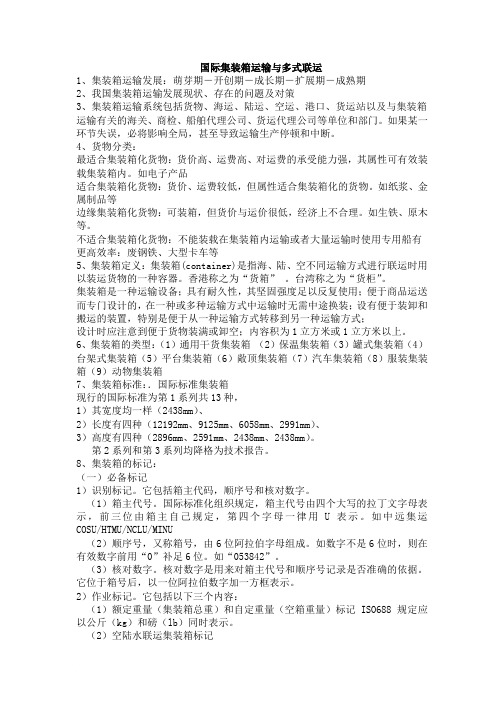
国际集装箱运输与多式联运1、集装箱运输发展:萌芽期-开创期-成长期-扩展期-成熟期2、我国集装箱运输发展现状、存在的问题及对策3、集装箱运输系统包括货物、海运、陆运、空运、港口、货运站以及与集装箱运输有关的海关、商检、船舶代理公司、货运代理公司等单位和部门。
如果某一环节失误,必将影响全局,甚至导致运输生产停顿和中断。
4、货物分类:最适合集装箱化货物:货价高、运费高、对运费的承受能力强,其属性可有效装载集装箱内。
如电子产品适合集装箱化货物:货价、运费较低,但属性适合集装箱化的货物。
如纸浆、金属制品等边缘集装箱化货物:可装箱,但货价与运价很低,经济上不合理。
如生铁、原木等。
不适合集装箱化货物:不能装载在集装箱内运输或者大量运输时使用专用船有更高效率:废钢铁、大型卡车等5、集装箱定义:集装箱(container)是指海、陆、空不同运输方式进行联运时用以装运货物的一种容器。
香港称之为“货箱”。
台湾称之为“货柜”。
集装箱是一种运输设备;具有耐久性,其坚固强度足以反复使用;便于商品运送而专门设计的,在一种或多种运输方式中运输时无需中途换装;设有便于装卸和搬运的装置,特别是便于从一种运输方式转移到另一种运输方式;设计时应注意到便于货物装满或卸空;内容积为1立方米或1立方米以上。
6、集装箱的类型:(1)通用干货集装箱(2)保温集装箱(3)罐式集装箱(4)台架式集装箱(5)平台集装箱(6)敞顶集装箱(7)汽车集装箱(8)服装集装箱(9)动物集装箱7、集装箱标准:.国际标准集装箱现行的国际标准为第1系列共13种,1)其宽度均一样(2438mm)、2)长度有四种(12192mm、9125mm、6058mm、2991mm)、3)高度有四种(2896mm、2591mm、2438mm、2438mm)。
第2系列和第3系列均降格为技术报告。
8、集装箱的标记:(一)必备标记1)识别标记。
它包括箱主代码,顺序号和核对数字。
(1)箱主代号。
《集装箱运输与多式联运》课程标准
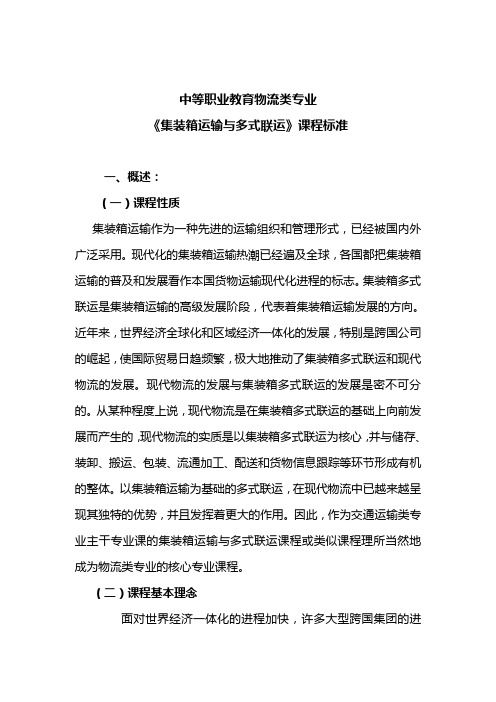
中等职业教育物流类专业《集装箱运输与多式联运》课程标准一、概述:(一)课程性质集装箱运输作为一种先进的运输组织和管理形式,已经被国内外广泛采用。
现代化的集装箱运输热潮已经遍及全球,各国都把集装箱运输的普及和发展看作本国货物运输现代化进程的标志。
集装箱多式联运是集装箱运输的高级发展阶段,代表着集装箱运输发展的方向。
近年来,世界经济全球化和区域经济一体化的发展,特别是跨国公司的崛起,使国际贸易日趋频繁,极大地推动了集装箱多式联运和现代物流的发展。
现代物流的发展与集装箱多式联运的发展是密不可分的。
从某种程度上说,现代物流是在集装箱多式联运的基础上向前发展而产生的,现代物流的实质是以集装箱多式联运为核心,并与储存、装卸、搬运、包装、流通加工、配送和货物信息跟踪等环节形成有机的整体。
以集装箱运输为基础的多式联运,在现代物流中已越来越呈现其独特的优势,并且发挥着更大的作用。
因此,作为交通运输类专业主干专业课的集装箱运输与多式联运课程或类似课程理所当然地成为物流类专业的核心专业课程。
(二)课程基本理念面对世界经济一体化的进程加快,许多大型跨国集团的进入,我国各级政府部门和许多市场意识敏锐的企业已把物流作为提高竞争能力和提升企业核心竞争力的重要手段,把现代物流理念、先进的物流技术和现代经营与管理模式引入国家、地区经济建设和企业经营与管理之中,但是,我国的物流教育仍十分滞后,加速推动现代物流产业的人才培养工程,实施多层次、多样化的物流教育,是21实际物流产业化发展中保证物流产业形成合理的人才结构,提高我国物流管理水平和经济效益的决定因素。
本课程以全面提高素质为基础,以增强职业能力为本位,以企业需求为基本依据,以就业为导向,适应行业技术发展,体现教学内容的先进性和以学生为中心,体现教学组织的科学性和适用性为原则,为培养高技能应用型物流人才提供基础。
(三)课程设计思路本课程按照“理论知识够用、实践技能扎实”,“理论教学和实训有机结合”的思路来设计课程结构,要有重点地安排理论和方法的学习,有机地联系岗位实践需求进行实训。
集装箱运输与多式联运
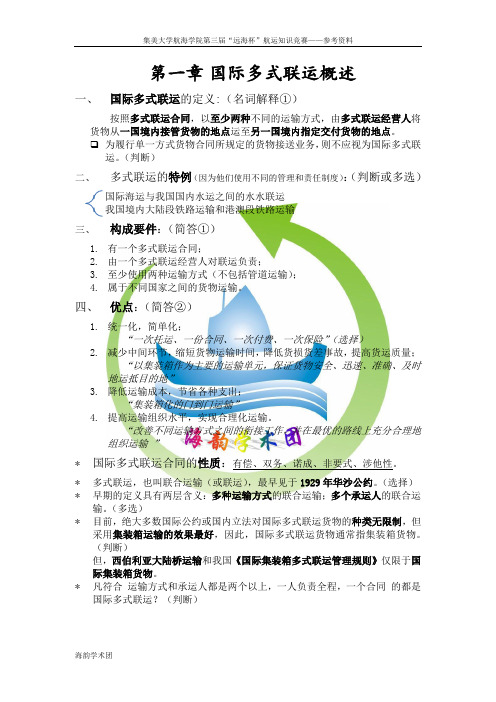
第一章国际多式联运概述一、国际多式联运的定义:(名词解释①)按照多式联运合同,以至少两种不同的运输方式,由多式联运经营人将货物从一国境内接管货物的地点运至另一国境内指定交付货物的地点。
为履行单一方式货物合同所规定的货物接送业务,则不应视为国际多式联运。
(判断)二、多式联运的特例(因为他们使用不同的管理和责任制度):(判断或多选)国际海运与我国国内水运之间的水水联运我国境内大陆段铁路运输和港澳段铁路运输三、构成要件:(简答①)1.有一个多式联运合同;2.由一个多式联运经营人对联运负责;3.至少使用两种运输方式(不包括管道运输);4.属于不同国家之间的货物运输。
四、优点:(简答②)1.统一化,简单化;“一次托运、一份合同、一次付费、一次保险”(选择)2.减少中间环节,缩短货物运输时间,降低货损货差事故,提高货运质量;“以集装箱作为主要的运输单元,保证货物安全、迅速、准确、及时地运抵目的地”3.降低运输成本,节省各种支出;“集装箱化的门到门运输”4.提高运输组织水平,实现合理化运输。
“改善不同运输方式之间的衔接工作,并在最优的路线上充分合理地组织运输”*国际多式联运合同的性质:有偿、双务、诺成、非要式、涉他性。
*多式联运,也叫联合运输(或联运),最早见于1929年华沙公约。
(选择)*早期的定义具有两层含义:多种运输方式的联合运输;多个承运人的联合运输。
(多选)*目前,绝大多数国际公约或国内立法对国际多式联运货物的种类无限制,但采用集装箱运输的效果最好,因此,国际多式联运货物通常指集装箱货物。
(判断)但,西伯利亚大陆桥运输和我国《国际集装箱多式联运管理规则》仅限于国际集装箱货物。
*凡符合运输方式和承运人都是两个以上,一人负责全程,一个合同的都是国际多式联运?(判断)第二章国际多式联运经营人一、多式联运经营人的定义:(名词解释②)MTO是指本人或通过其代表订立多式联运合同的任何人,他是当事人,而不是托运人的代理人或代表或参加多式联运的承运人的代理人或代表,并且负有履行合同的责任。
集装箱运输与多式联运,复习总结提纲

第一章 绪论集装箱运输:是指以集装箱这种大型容器为载体,将货物集合组装成集装单元,以便在现代流通领域内运用大型装卸机械和大型载运车辆进行装卸、搬运作业和完成运输任务,从而更好地实现货物"门到门”运输的一种新型、高效率和高效益的运输方式。
集装箱运输发展:1、 萌芽期(19世纪初~20世纪50年代中期) 起源于英国2、 开创期(20世纪50年代中期~20世纪60年代中期) 发扬与美国3、 扩展期(20世纪60年代中期~20世纪80年代中期) 扩展至东南亚、中东、南非4、 成熟期多式联运:多式联运,按联合运输的地域范围划分,可划分为国内多式联运和国际多式联运两种集装箱多式联运,可划分为国内集装箱多式联运和国际集装箱多式联运。
多式联运特点:是由多式联运经营人与托运人签订一个运输合同,统一组织全程运输,实现运输全程的一次托运、一单到底、一次收费、统一理赔和全程负责。
多式联运优点:1、 统一化、简单化2、 减少中间环节,提高运输质量3、 降低运输成本,节约运杂费用4、 扩大运输经营人业务范围,提高运输组织水平,实现合理运输 集装箱运输与多式联运系统:1、适箱货源及揽货管理子系统23、集装箱货运站作业管理子系统4、集装箱码头及装卸作业管理子系统5、船舶运输组织子系统6、公路运输组织子系统7、铁路运输组织子系统8、航空运输组织子系统9、租赁管理子系统:箱出租公司、船出租公司10、政府和国家监管子系统11、其他子系统:班轮公会、全程联运保赔协会集装箱运输与多式联运的发展变化:1、箱型有大型化、专用化的发展趋势2、干线船向大型化、高速化发展;3、集装箱港口向大型、高效、综合服务方向发展;4、港口的中转作用日益重要;5、多式联运日益完善;6、经营规模化;7、信息管理实现现代化。
第三章集装箱及箱务管理集装箱空箱调运产生的原因:1、管理方面的原因,如单证交接不全,流转不畅,影响空箱的调配和周转;2、进出口货源不平衡,造成进、出口集装箱比例失调;3、贸易逆差导致集装箱航线货流不平衡;4、进出口货物种类和性质不同,需要使用不同规格的集装箱,产生不同规格集装箱短缺,需要调运不同规格集装箱空箱;5、其它原因,如出于对修箱费用和修箱要求考虑,船公司将空箱调运至修费低、修箱质量高的地区去修理。
集装箱运输与国际多式联运的分析

集装箱运输与国际多式联运的分析经管系专业论⽂集装箱运输与国际多式联运的分析系:经济与管理系专业:⼯商管理班级:07- 1 班学号:姓名:⽬录⼀、集装箱运输与国际多式联运的发展 (1)⼆、集装箱运输的重要作⽤ (2)1、实现了运输操作机械化 (2)2、⽅便了⽤户,提⾼了服务质量,缩短了商品在途时间 (2)3、保证了商品运输安全 (3)4、降低了运输和包装费⽤ (3)5、推动了包装标准化的进程 (3)6、有利于综合利⽤各种运输⼯具和扩⼤联合运输 (4)三、国际多式联运的优越性 (4)四、集装箱运输和国际多式联运发展中的阻碍 (5)1、海关制度的阻碍 (5)2、集装箱规格不统⼀带来的阻碍 (6)3、集装箱港⼝建设问题 (7)五、当前集装箱运输中存在的问题 (8)(⼀)我国集装箱运输发展的内部因素 (8)1.经济发展的先决因素 (8)2.产业结构的促进因素 (9)3.外贸发展的主导因素 (9)4.港⼝集约化的保障因素 (9)(⼆)我国集装箱运输发展的外部因素 (10)1.政府倡导的推动因素 (10)2.物流发展的催化因素 (10)3.国际竞争的激励因素 (11)六、结束语 (11)[参考⽂献]..................................... 错误!未定义书签。
集装箱运输与国际多式联运的分析摘要:本⽂章从集装箱运输的发展开始,论述了集装箱运输与国际多式联运的关系,分析集装箱运输的重要作⽤并进⼀步阐述了国际多式联运的优势及对全球贸易的重要性。
但是由于存在技术⽅⾯的原因,存在不同国家对集装箱运输有着不同的海关制度等原因,集装箱运输和国际多式联运也存在⼀些阻碍,这些阻碍尚需要⼀定的时间和措施来扫除。
进⽽⼜提出我国集装箱运输发展所存在的问题,影响其发展的因素,这些都是我们所要考虑的。
关键词:集装箱运输国际多式联运包装港⼝国际多式联运以集装箱为单元进⾏运输,运输途中换装时⽆需换箱、装箱,减少了中间环节,降低了货损货差事故;尽管要经过⾄少两种运输⽅式的衔接,但由于使⽤专业机械装卸,中转迅速及时,⼤⼤减少了货物停留时间;国际多式联运⽅式下,做到了⼀次托运、⼀单到底、⼀次收费、统⼀理赔和全程负责,⼤⼤⽅便了货主;货主在将货物交由第⼀承运⼈后即可取得货运单证,凭多式联运提单⽆需等货物将上船就能结汇,结汇时间的提前,带来的是资⾦周转加速,减少了利息⽀出。
(交通运输)国际多式联运与集装箱运输
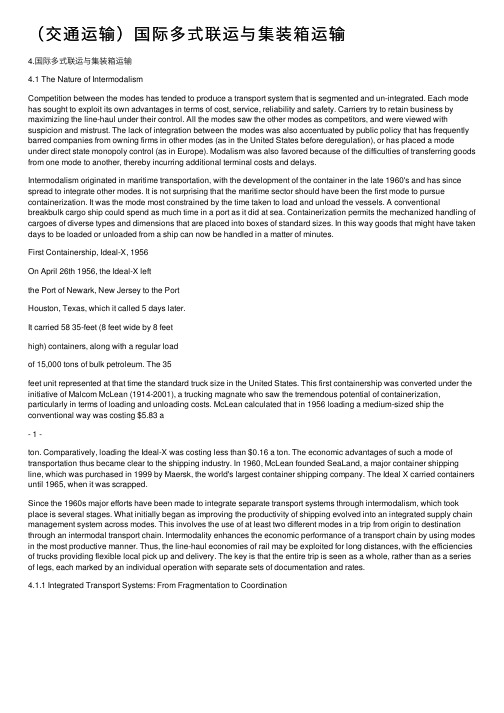
(交通运输)国际多式联运与集装箱运输4.国际多式联运与集装箱运输4.1 The Nature of IntermodalismCompetition between the modes has tended to produce a transport system that is segmented and un-integrated. Each mode has sought to exploit its own advantages in terms of cost, service, reliability and safety. Carriers try to retain business by maximizing the line-haul under their control. All the modes saw the other modes as competitors, and were viewed with suspicion and mistrust. The lack of integration between the modes was also accentuated by public policy that has frequently barred companies from owning firms in other modes (as in the United States before deregulation), or has placed a mode under direct state monopoly control (as in Europe). Modalism was also favored because of the difficulties of transferring goods from one mode to another, thereby incurring additional terminal costs and delays.Intermodalism originated in maritime transportation, with the development of the container in the late 1960's and has since spread to integrate other modes. It is not surprising that the maritime sector should have been the first mode to pursue containerization. It was the mode most constrained by the time taken to load and unload the vessels. A conventional breakbulk cargo ship could spend as much time in a port as it did at sea. Containerization permits the mechanized handling of cargoes of diverse types and dimensions that are placed into boxes of standard sizes. In this way goods that might have taken days to be loaded or unloaded from a ship can now be handled in a matter of minutes.First Containership, Ideal-X, 1956On April 26th 1956, the Ideal-X leftthe Port of Newark, New Jersey to the PortHouston, Texas, which it called 5 days later.It carried 58 35-feet (8 feet wide by 8 feethigh) containers, along with a regular loadof 15,000 tons of bulk petroleum. The 35feet unit represented at that time the standard truck size in the United States. This first containership was converted under the initiative of Malcom McLean (1914-2001), a trucking magnate who saw the tremendous potential of containerization, particularly in terms of loading and unloading costs. McLean calculated that in 1956 loading a medium-sized ship the conventional way was costing $5.83 a- 1 -ton. Comparatively, loading the Ideal-X was costing less than $0.16 a ton. The economic advantages of such a mode of transportation thus became clear to the shipping industry. In 1960, McLean founded SeaLand, a major container shipping line, which was purchased in 1999 by Maersk, the world's largest container shipping company. The Ideal X carried containers until 1965, when it was scrapped.Since the 1960s major efforts have been made to integrate separate transport systems through intermodalism, which took place is several stages. What initially began as improving the productivity of shipping evolved into an integrated supply chain management system across modes. This involves the use of at least two different modes in a trip from origin to destination through an intermodal transport chain. Intermodality enhances the economic performance of a transport chain by using modes in the most productive manner. Thus, the line-haul economies of rail may be exploited for long distances, with the efficiencies of trucks providing flexible local pick up and delivery. The key is that the entire trip is seen as a whole, rather than as a series of legs, each marked by an individual operation with separate sets of documentation and rates.4.1.1 Integrated Transport Systems: From Fragmentation to CoordinationThe notion of integrated transport systems received a lot of attention, particularly with improvements in the capacity, efficiency and reliability of freight transport- 2 -systems. The conventional fragmented and sub-optimal freight transport systems have substantially been improved. A process of coordination of freight transport is taking place. Several factors can be pondered:(1) TechnologyTechnology has been a prime driving force. Containerization is without any doubt the most significant technological factor behind a more efficient coordination of transport modes. Innovations include modes, such as post-panamax containerships or double-stacking trains, but also intermodal equipment to handle significant transshipment demands. Hard (technical) assets require soft (management) assets. Information technologies have gone a long way to help improving the level of control over supply chains, which includes important aspects such as tracking shipments and managing fleets. The issue of e-commerce has particularly received attention.(2) Capital intensive sectorFreight transportation is a capital intensive sector with high entry costs for the maritime and rail segments. The amortization of modes and infrastructures, particularly terminals, has to be spread over a significant time period, sometimes over more than a decade. This environment is prone to risks and many potential investors are unwilling to commit capital for infrastructure projects. This a reason why the government has often been called to step in. Still, freight transport companies are dominantly private entities and must rely on capital markets to finance their ventures. If through a higher level of coordination with other elements of the supply chain a greater quantity and stability in utilization can be secured, capital costs can be reduced and financial returns improved. Thus, intermodal projects have potentially a lower capital risk.(3) New forms of relationshipsCoordination also implies new forms of relationships between freight forwarders. This was favored by the deregulation of many transport modes in the early 1980s. The Aviation Deregulation Act (1979), the Staggers Act (1980), the Motor Carrier Act (1980) and the Ocean Shipping Act (1984) are significant landmarks in this direction. It became easier for different transport operators to establish contractual agreements. Mergers / acquisitions within the same mode started to take place, mainly in maritime and rail transportation, but also modal and- 3 -intermodal alliances.(4) Global commodity chainsGlobalization has permitted the emergence of a structure of production, often known as global commodity chains or global production networks. This structure requires a high level of coordination. It is thus expected that this production structure imposes a similar structure of distribution where coordination between modes and different transport systems is required. Under such circumstances, transport demand should increasingly be considered as integrated.(5) NetworksFinally, integrated transport systems rely on the respective strengths of each transport networks. Since networks areexpensive to build and operate, linking them promotes efficiency and a higher level of control. This can be considered as a multiplying effect where the efficiency of the whole intermodal network is higher than the sum of its parts.4.1.2 Evolution of Intermodal IntegrationIt can be argued that three major paradigm shifts have taken place within containerized freight distribution systems:(1) Containerization of maritime transport systems.At first, the introduction of the container and its penetration within maritime systems took place. This is particularly the case from the mid 1965s when- 4 -standardization resulted in common container size and latching systems. The efficiency of port transshipments improved and inland services, dominantly relying on trucking, began to be established. Still, maritime services tended to be on a point-to-point basis and between major ports.(2) Containerization of inland transport systems.Containerization moved inland, mainly in an attempt to improve the continuity already established within maritime transportation, particularly with the setting of pendulum services. The introduction of doublestacking rail services in the mid 1980s required the setting and redesign of inland container rail terminals in North America. The adoption of the container in Europe gained momentum when an intermodal system started to emerge in the late 1970s. For example, the shift from conventional and highly irregular barge services to scheduled and reliable container services in the second half of the 1970s gave impetus to a fast containerization process along the Rhine basin up to the main ports of Rotterdam and Antwerp.(3) Intermodal and transmodal operations.Since containerization has expanded to cover maritime and inland transport systems, the next phase dominantly aims at improving its overall efficiency. This efficiency is mainly based in the reduction of the number of times a container is handled as well as the velocity at which intermodal and transmodal operations are performed. Also, the growth in containerized shipments placed additional pressures on intermodal transport systems, which for the maritime segment resulted in the setting of offshore hubs. They mainly act as intermediary locations between major systems of maritime circulation/ Establishment of commodity chains. Inland transport systems accommodated a growing amount of traffic, which in many cases resulted in the setting of large inland freight distribution centers (inland ports).- 5 -4.1.3 Intermodal Transport ChainFour major functions define an intermodal transport chain:(1) Composition.The process of assembling and consolidating freight at a terminal that offers an intermodal interface between a local / regional distribution system and a national / international distribution system. Commonly referred as the "first mile". Ideally, loads of freight coming from different suppliers are assembled at distribution centers so they can be forwarded to high capacity modes such as rail and maritime shipping. The dominant mode for such a process tends to be trucking as it offers flexibility and door-to-door services. Activities such as packaging and warehousing are also included in the composition process, which is closely linked with the function of production.(2) Connection.Involves a consolidated modal flow, such as a freight train or a containership (or even fleets of trucks), between at least two terminals, which takes place over national or international freight distribution systems. The efficiency of a connection mainly is mainly derived from economies of scale, such as doublestacking or post-panamax containerships, coupled with an adequate frequency of service.(3) Interchange.The major intermodal function takes place at terminals whose purpose is to provide an efficient continuity within a transport chain. Those terminals are dominantly within the realm of national or international freight distribution systems,- 6 -with ports (transshipment hubs) being the most notable example.(4) Decomposition.Once a load of freight has reached a terminal close to its destination, it has to be fragmented and transferred to the local / regional freight distribution system. Commonly referred as the "last mile" and often represents one of the most difficult segments of distribution. This function, which is linked with the function of consumption, dominantly occurs within metropolitan areas and involves unique distribution problems also known as urban logistics.4.1.4 Integrated Freight Transport Systems: Intermodal and Transmodal OperationsFrom a functional and operational perspective, two components are involved inintermodalism:Intermodaltransportation. Themovements ofpassengers or freightfrom one mode oftransport to another,commonly takingplace at a terminalspecifically designedfor such a purpose.Transmodal transportation. The movements of passengers or freight within the same mode of transport. Although "pure" transmodal transportation rarely exists and an intermodal operation is often required (e.g. ship to dockside to ship), the purpose is to insure continuity within the network.The function of transshipment is of core importance in contemporary freight distribution as it is concomitantly an intermodal and a trans-modal activity. In integrated transport systems the time component has become increasingly significant. Since modal speed improvements tend to be marginal, it is at the terminal and with- 7 -the function of transshipment that most of the time and cost benefits are achieved. Transshipment is more than an intermodal activity; that is movements between modes. It also concerns movements within segments of the same mode; modal transshipment. As commodity chains became more complex and longer the pressure on intermodal and trans-modal transportation has increased. In this geography of transshipments connecting different parts of the transport systems, freight markets and freight forwarders are interacting with increasing efficiency. Intermodal transshipments have received the bulk of the attention, particularly their port and rail terminals segments, as massive investments in those facilities were required to set global commodity chains. However, intramodal transshipments are comparatively uncovered, the main reason being that until recently they mainly took place within fragmented and regulated national transport systems. The three main transmodal dimensions include:(1) Transmodal roadMainly takes place at distribution centers, which have become strategic elements in freight distribution systems. It is probably one of the few cases where intramodal transshipments can be combined with added value activities, such as labeling and packaging. Although distribution centers were conventionally warehousing facilities in which commodities could be stored while waiting to be sold to customers down the supply chain, this function has substantially receded. Time constraints in freight distribution impacted on road based distribution centers, whose function is increasingly related to transmodal operations and much less to warehousing. The true time-dependent intramodal facility remains the cross-docking distribution center.(2) Transmodal maritimeShip-to-ship transshipments mainly concerns intermediary hubs such as in the Caribbean, the Mediterranean or ship-to-barge activities. Although in many cases the containers are actually unloaded onto a temporary storage facility (commonly next to the piers), an off-shore hub is functionally a transmodal facility. They have emerged at intermediary locations by offering transshipment advantages in view of costs related to pendulum multiport services coupled with lower container handling cost related to transshipment-only terminals, in addition to economies of scale for feeder ships.(3) Transmodal rail- 8 -Probably represents one of the least investigated segments of transmodal transportation. Most rail systems were built to service specific markets and were heavily regulated. It is only recently that containerization created the need for transmodal functions in rail transport systems, since rail transportation was forced to address a new variety of movements, many of them with international origins or destinations. Initially, rail developed greater intermodal efficiencies with maritime and road transport systems, particularly because this represented new market opportunities.4.1.5 Intermodal Transportation as an Integrative ForceThus, transportation systems having several modes can be considered from two different conceptual perspectives:(1) Intermodal Transportation Network.A logistically linked system using two or more transport modes with a single rate. Modes are having common handling characteristics, permitting freight (or people) to be transferred between modes during a movement between an origin and a destination. For freight, it also implies that the cargo does not need to be handled, just the load unit such as a pallet or a container.(2) Multimodal Transportation Network.A sequence of transport modes offering connections between a set of origins and destinations. However, these connections imply that the load unit needs to be changed, which is common for bulk transportation.- 9 -Intermodality can be conceived as the transition from one mode of transportation to another, and is organized around the followings concepts:●The nature and quantity of the transported commodities;●The modes of transportation being used;●The origins and destinations;●Transportation time and costs;●The value of the commodities and the frequency of shipment.The above figures illustrate two alternatives to freight distribution. The first is a conventional point-to-point multimodal network where origins (A, B and C) are independently linked to destinations (D, E and F). In this case, two modes (road and rail) are used. The second alternative involves the development of an integrated intermodal transport network with common load units (containers). Traffic converges at two transshipment points, rail terminals, where loads are consolidated. This can result in higher load factors and/or higher transport frequency, especially between terminals. Under such circumstances, the efficiency of such a network mainly resides in the transshipment capabilities of transport terminals.4.1.6 Intermodalism technologyThe emergence of intermodalism has been brought about in part by technology and requires management units for freight such as containers, swap bodies, pallets or semi-trailers. In the past, pallets were a common management unit, but their relatively small size and lack of protective frame made their intermodal handling labor intensive and prone to damage or theft. By the early 1930s about three days were required to unload a rail boxcar containing 13,000 cases of unpalletized canned goods. With pallets and forklifts, a similar task could be done in about four hours. Better techniques and management units for transferring freight from one mode to another have facilitated intermodal transfers. Early examples include piggyback (TOFC: Trailers On Flat Cars), where truck trailers are placed on rail cars, and LASH (lighter aboard ship), where river barges are placed directly on board sea-going ships.Piggyback and Doublestack Train Cars- 10 -One of the first attempts at piggybacking dates back to 1872 when the Barnum & Bailey Circus used its own special train of flat railroad cars to tour cities in the United States. It took 3 to 5 hours and considerable effort to unload and load trailers, butthe concept remained and piggybacking started to be adopted by railroad operators. By the 1950s piggybacking became increasingly used and a good source of income for rail companies.Containerization however changed piggybacking to stacking and then to doublestacking where possible. Doublestacking of containers (Container on Flat Car; COFC) saves much more convoy space than the piggyback method (Trailer on Flat Car; TOFC) with the added advantage of not to have to carry a trailer. However, several rail lines are not compatible with doublestacking because of the required height clearance for bridges and tunnels (5.5 meters). Converting a rail line to doublestacking can be a costly undertaking, especially on the much older European rail system where bridge clearances tend to be lower. In North America, such investments are done over high priority corridors.While handling technology has influenced the development of intermodalism, another important factor has been changes in public policy. Deregulation in the United States in the early 1980s liberated firms from government control. Companies were no longer prohibited from owning across modes, and there developed a strong impetus towards intermodal cooperation. Shipping lines in particular, began to offer integrated rail and road service to customers. The advantages of each mode could be exploited in a seamless system, which created multiplying effects. Customers could purchase the service to ship their products from door to door, without having to concern themselves of modal barriers. With one bill of lading clients can obtain one- 11 -through rate, despite the transfer of goods from one mode to another.The most important feature of intermodalism is the provision of a service with one ticket (for passengers) or one bill of lading (for freight). This has necessitated a revolution in organization and information control. At the heart of modern intermodalism are data handling, processing and distribution systems that are essential to ensure the safe, reliable and cost effective control of freight and passenger movements being transported by several modes. Electronic Data Interchange (EDI) is an evolving technology that is helping companies and government agencies (customs documentation) cope with an increasingly complex global transport system.4.1.7 Multimodal Transport SystemToday, intermodal transport is transforming a growing share of the medium and long-haul freight flows across the globe. Large integrated transport carriers provide door to door services. The limits of intermodality are imposed by factors of space, time, form, pattern of the network, the number of nodes and linkages, and the type and characteristic of the vehicles and terminals.A multimodal transport system integrates different geographical scales from the global to the local. With the development of new modal and intermodal infrastructure, urban regions have a growing accessibility to the international market; several parameters of regional transportation are transformed, or at least significantly- 12 -modified. The above figure represents the regulation of movements of a corridor within a multimodal transportation system composed of a set of competing hub centers where converge regional and local transportation networks. Depending on the geographical scale being considered, the regulation of flows is coordinated at the local level by distribution centers, commonly composed of a single transport terminal, or at the global level by articulation points, composed of major transport terminals and related activities.An articulation point can simultaneously have a modal and intermodal convergence of functions; particularly if it is the interface between several modes. Its modal function relates to its while its intermodal function indicates its level of service. The regional multimodal network converges at major articulation points allowing linkages with the international transportation system through a maritime / land interface. Port cities are the main agent of that function. Containerization has particularly developed the maritime / land interface. It insures flexibility of shipments and several ports have opted for this multimodal transportation technology to keep and consolidate their status of hub center.4.2 Containerization4.2.1 IntroductionThe driver of intermodal transportation has undoubtedly been the container, which permits easy handling between modal systems:Container. A large standard size metal box into which cargo is packed for shipment aboard specially configured transport modes. It is designed to be moved with common handling equipment enabling high-speed intermodal transfers in economically large units between ships, railcars, truck chassis, and barges using a minimum of labor. The container, therefore, serves as the load unit rather than the cargo contained therein, making it the foremost expression of intermodal transportation. The usage of containers shows the complementarity between freight transportation modes by offering a higher fluidity to movements and a standardization of loads. Thus, the relevance of containers is not what they are - simple boxes -but what they enables; intermodalism. The reference size is the 20 foot box, 20 feet long, 8'6" feet high and 8 feet wide, or 1 Twenty-foot Equivalent Unit (TEU). Since the- 13 -great majority of containers are now forty foot long, the term Forty-foot Equivalent Unit (FEU) is also used, but less commonly. Post Panamax Containership at the Port of Le HavreTerminal de l'Ocean is one container terminal inthe Port of Le Havre, France, that is partially ownedby the maritime shipping company MSC(Mediterranean Shipping Company). When this photowas taken, the MSC Diego, built in 1999 and a typicalPost Panamax containership with a capacity of justover 4,000 TEU, was being serviced. The vessel is 260meters long, 32 meters wide and has a beam of 19meters. Very large cranes are required to transship its containerized cargo, which is 13 containers wide.40-Foot Containers Doublestacked on a Rail CarDouble stacking rail services were firstintroduced in North America in 1984, multiplying theproductivity of inland container shipping. Untilrecently, North America remained the only region ofthe world where double stacking services werepossible. In April 2004 double-stack container trainservices using 40 foot boxes between Shanghai andBeijing were launched. Both cities can be serviced in about 38 hours.20-Foot Container on TruckThe 20 foot container was the first intermodalcontainer unit to receive wide acceptance as it wasset as an ISO standard. Although for many supplychains, particularly those concerning retail, the 40foot container tends to be privileged, there is still asubstantial market for the 20 foot container. Weightycommodities as best moved in 20 footer loads.- 14 -4.2.2 container(1) Main Physical Characteristics of ContainersSource: adapted from APL, Equipment SpecificationsThe above table underlines several options in container size. Many shippers prefer to use the largest load unit possible (e.g.40 footer high cube) because it conveys economies of scale. However, weight restrictions can make the 20 footer a desirable option, particularly for the transport of commodities. For instance, the weight restrictions on both the regular and the high cube forty footers are at around 30 short tons (or 28 metric tons), essentially the same than a 20 footer, so there are no- 15 -gains in using a high cube container for ponderous goods. Payload weight even gets smaller with 45 and 48 foot containers, underlining their specific role for the transport of goods that are bulky but comparatively light. The majority of container are made with weathering steel (Corten steel) which prevents rusting.(2) Carrying Capacity of Containers (in cubic feet)Source: adapted from Robert C. Leachman (2005) Port and Modal Elasticity Study, Dept. of Industrial Engineering and Operations Research, University of California at Berkeley.The initial container sizes were the "20 footer" and the "40 footer" agreed upon in the 1960s and became an ISO standard. Initially, the "20 footer" was the most widely used container. However, as containerization became widely adopted in the 1990s, shippers switched to larger container sizes, notably the "40 footer". Larger sizes confer economies of scale in loading, handling and unloading, which are preferred for long distance shipping as well as by customers shipping large batches of containerized commodities. The same ship capacity would take in theory twice as much time to load or unload if 20 footers where used instead of 40 footers. There is thus an evident rationale to use the largest container size possible. Consequently, the 20 footer is gradually been phased out. "Hi cube" containers have also been put in use, notably since they do not require different handling equipment or road clearance. They are one feet higher (9'6") than the standard 8'6" height and a 40 footer hi-cube container provides about 12% more carrying capacity than its standard counterpart. Most North American double stack rail corridors can handle two stacked hi-cube containers, creating an additional multiplying effect in terms of total capacity per rail- 16 -car. The 53 feet hi-cube container is solely a domestic container used in the United States between rail and trucking.The European Union is trying to implement a new container labeled the European Intermodal Load Unit (EILU), which would have a length of 45 feet and a width of 8.5 feet. The rationale behind this standard is that it would allow two of the standard European pallets to be placed in containers side by side as existing containers are based on North American pallet dimensions. While the new dimensions would still meet clearances for road and rail transport in Europe as well as abroad, the EILU is being strongly opposed by maritime shipping lines, because they have huge investments in current equipment and new ships under construction are optimized for existing ISO container sizes. Because containers have a useful life of about 12 to 15 years, intermodal carriers are reluctant to adopt any new standard because of prior commitments in capital investment in modal and intermodal infrastructures.(3) Number of Units and Weight of Standard Consumption Goods that Can be Carried by a 20 Foot ContainerSource: adapted from T. Toikka (2006) "The Real Price for Container Transportation between Asia and Europe", Lappeenranta University of Technology, Department of Industrial Engineering and Management.Depending of the characteristics of the goods being carried, namely the weight-to-volume ratio, a 20 footer may not be the optimal containerized unit. For instance twice as much cell phones, DVD players or shoes could be carried on a 40 footer。
- 1、下载文档前请自行甄别文档内容的完整性,平台不提供额外的编辑、内容补充、找答案等附加服务。
- 2、"仅部分预览"的文档,不可在线预览部分如存在完整性等问题,可反馈申请退款(可完整预览的文档不适用该条件!)。
- 3、如文档侵犯您的权益,请联系客服反馈,我们会尽快为您处理(人工客服工作时间:9:00-18:30)。
(交通运输)集装箱运输与多式联运集装箱运输与多式联运第一章集装箱运输管理概述第一节全球集装箱运输概况一、集装箱运输的发展沿革1.1830年至1956年为集装箱运输的萌芽期。
(1)世界上最早出现的集装箱运输雏形⏹1830年在英国铁路上,首先出现了一种装煤的容器;⏹1853年美国铁路也采用了容器装运法。
(2)正式使用集装箱是在20世纪初期⏹1900年,英国铁路上首先出现了较为简单的集装箱运输;⏹1917年美国在铁路上试行集装箱运输;随后在短短的10余年间,德、法、日、意相继出现了集装箱运输。
(3)30年代至40年代末,集装箱运输发展缓慢。
⏹公路运输迅速发展,与铁路运输产生了激烈的竞争,影响到铁路和公路集装箱联运;⏹开展集装箱运输所需投资大。
⏹2.1956年至1966年为集装箱运输的开创期⏹(1)“马科斯顿号”:1956年4月,美国泛大西洋轮船公司在一艘T-2型油船甲板上设置了一个可装载58只35ft集装箱的平台,取名“马科斯顿号”,航行于纽约至休斯顿航线上。
经过3个月的试运行后,“马科斯顿号”获得了巨大的经济效果,平均每吨货物的装卸费从原来的5.83美元下降到0.15美元,仅为原来装卸费的1/37。
⏹(2)“盖脱威城号”:该公司于1957年10月又将一艘C-2型货船改装成吊装式全集装箱船,取名“盖脱威城号”,载重量9000t,可装载226个35ft集装箱,这是世界上第一艘全集装箱船。
⏹(3)海陆运输公司:1960年4月,泛大西洋轮船公司改名海陆运输公司。
1961年5月,该公司陆续开辟了纽约—洛杉矶—旧金山航线和阿拉斯加航线,从而奠定了在国内进行集装箱运输的基础。
⏹(4)该时期的重要特征:这一时期所使用的船舶都是经济货船改装成的集装箱船,没有专用集装箱泊位,使用的都是非标准的17ft,27ft和35ft的集装箱,集装箱运输航线局限于美国国内。
⏹3.1966年起,集装箱运输进入了成长期。
⏹1966年4月海陆运输公司以经过改装的全集装箱船开辟了纽约—欧洲集装箱运输国际航线。
⏹1967年9月马托松船公司将“夏威夷殖民者”号全集装箱船投入到日本—北美太平洋沿岸航线。
⏹紧接着日本和欧洲各国的船公司先后在日本、欧洲、美国和澳大利亚等地区开展了集装箱运输。
⏹该时期重要特征:⏹(1)集装箱运输从美国本土逐步走向国际化,⏹(2)从事集装箱运输的船舶是中小型集装箱船(第一代集装箱船),载箱量为700TEU~l000TEU,⏹(3)出现了集装箱专用泊位,⏹(4)集装箱规格趋于国际标准化,统一采用国际标准化组织ISO所规定的20ft、40ft的标准集装箱。
⏹4.从1971年起,集装箱运输步入扩展期。
⏹1971年底,世界13条主要航线基本上实现了件杂货集装箱化。
集装箱船舶运输能力迅速增加,1970年约为23万TEU,1983年达到208万TEU。
⏹该时期重要特征:⏹(1)集装箱船舶运输能力迅速增加,出现了载箱量为2000TEU的第二代集装箱船;⏹(2)世界各国普遍建设集装箱专用泊位,1983年集装箱专用泊位达到983个,港口设施不断现代化,许多集装箱专用泊位开始配备跨运车、第二代集装箱装卸桥及堆场轮胎式龙门起重机;⏹(3)电子计算机得到更广泛采用,现代化管理水平有很大提高;⏹(4)1980年5月在日内瓦通过了《联合国国际货物多式联运公约》,并在美国出现了集装箱多式联运方式。
⏹5.80年代末,集装箱运输进入成熟期。
⏹经过40年的发展,海上集装箱运输己遍及全球,发达国家件杂货运输的集装箱化程度已达80%以上。
⏹该时期重要特征:⏹(1)与集装箱运输有关的硬件与软件日臻完善,各有关环节紧密衔接;⏹集装箱运输系统的现代化水平提高:集装箱船舶的大型化和全自动化、集装箱专用泊位高效率化、集装箱运输的集疏运系统等的配套建设,⏹管理方法科学化,管理手段现代化:广泛采用EDI(电子信息交换)系统,实现集装箱动态跟踪管理等。
⏹(2)集装箱运输多式联运获得迅速发展,发达国家之间的集装箱运输已基本实现了多式联运,发展中国家多式联运的增长势头也十分可观。
二.当前全球集装箱运输市场特征(一)集装箱船队的发展⏹(1)全球商船队中全集装箱船数量不断增多,船型不断增大;⏹(2)2001年前20名集装箱班轮承运人的运力占据了全球全集装箱船总运力的72%,占全部运输集装箱的船舶总运力的33%;⏹(3)三大主干航线上集中了全球71%的全集装箱船队;⏹(4)全集装箱船队在船舶数量尤其是运力上的增长速度,已经大大超过了全球经济贸易的发展。
(二)集装箱海运量的发展❑首先,20世纪90年代,全球集装箱货物运输飞速发展⏹1990年估计运量为8300万TEU,到2000年则达到了1.98亿TEU,年均增长9%。
⏹2000年全球集装箱运输中,运抵亚太地区的占50%,欧洲为21%,北美为14%,其他地区占14%。
⏹据预测,集装箱货物的饱和点大概是达到占全球货物的65%,2000年全球件杂货运输中,集装箱货物大约占54%。
❑其次,集装箱转运量呈不断攀升之特点。
⏹目前集装箱转运量约占全部集装箱港口集装箱吞吐量的四分之一⏹在一些比较特殊的港口如新加坡和科伦坡,转运量更高,达到港口集装箱吞吐量的70%。
(三)集装箱运费变动特点⏹近几年,集装箱班轮运输市场运价呈不断下降之趋势。
⏹东西向航线运价存在较大差异。
⏹进出不同地区港口的价格走势呈现各个不同的特点。
三.我国集装箱运输发展概况⏹1.从50年代开始起步,1955年4月,铁路部门开始办理国内小型集装箱运输;⏹2.水运部门在1956年、1960年和1972年三次借用铁路集装箱进行短期试运。
⏹3.中国集装箱化运输第一阶段:⏹1976年中国最早开始的集装箱航班:⏹由日本大阪商船三井营运的天津到日本航线;⏹由日本川崎汽船营运的上海到日本航线⏹1976年中国集装箱装卸量约7000箱⏹4.中国集装箱化运输第二阶段:⏹1978年中远集团开始集装箱运输,开辟了第一条集装箱运输航线:上海——澳大利亚东岸;⏹1980年我国集装箱码头开始配备专用集装箱装卸桥;⏹1981年中国集装箱吞吐量达11.4万TEU;⏹5.中国集装箱化运输第三阶段:⏹1982年起,中国航运公司开始起用大型集装箱船:⏹1982年,北美航线、欧洲航线上1400TUE船型⏹1988年,北美航线上投入2700TUE船型⏹1994年,欧洲航线上3800TUE船型⏹1998年,北美航线上5250TUE船型经过20多年的努力,我国国际集装箱运输历经了从无到有,从小到大的光辉历程:1.集装箱船舶运力有了巨大发展,航线不断扩大。
⏹1998年,全国从事国际集装箱运输的船公司150家,拥有全集装箱船和半集装箱船600余艘,箱位约30万TEU。
其中中远集运2001年为19.7万标准箱位,2001年排名世界第6位,中远集团船队经历了从小型集装箱船到第二、三、四、五代集装箱船的发展历程。
⏹2001年我国开辟远洋班轮699班/月,近洋班轮1218班/月,内支线班轮702班/月,不仅开辟了国内沿海至日本、香港、东南亚的近洋航线,还开辟了美洲、欧洲、地中海,形成了远、近洋结合,沿海、长江内支线相互衔接的运输网络,在远东至北美,远东至欧洲两大干线上,实现了具有国际水平的同班服务。
2.加强基础设施建设,港口条件有了明显改善。
⏹到1998年底,全国拥有集装箱专用泊位65个,年设计通过能力超过1000万TEU 。
装备了适应第三、四代集装箱船装卸作业的机械设备及其它设施,拥有大型岸边集装箱起重机124台,堆场龙门起重机283台,基本上满足了班轮作业的要求。
⏹2001年,集装箱吞吐量2748万TEU,比上年增长17%,前十大港口集装箱吞吐量占全国总量的84%;⏹3.基本建成了与班轮运输相配套的内陆中转货运站场网络⏹为了使内陆中转站、货运站与港口吞吐能力相适应,保证集疏运系统的畅通,到1995年底,在港口腹地、主要港站枢纽附近及12条公路主骨架沿线,建成国际集装箱内陆中转站达200多个,备有专用车辆1.5万余辆,2万余箱位,公路汽车运输已成为港口集装箱集疏运的主要力量,公路集疏运量占港口集装箱吞吐量的80%。
⏹4.依靠科技进步发展集装箱运输,集装箱运输管理水平有了很大提高⏹1988年~1991年,在国家计委等部(委)的支持配合下,交通部主持了“国际集装箱运输系统(多式联运)工业性试验”,在上海口岸通过设备配套、技术开发、制定规章、统一单证,发展和完善了以上海港为枢纽,向国外和内陆两个扇面辐射的干支线相衔接的国际集装箱运输系统和示范模式;⏹交通部在“九五”期间,进行“国际集装箱运输电子传输动作系统和示范工程”项目的研究和实施。
四、集装箱运输的特点⏹ 1.高效益的运输方式⏹1)简化包装,大量节约包装费用。
⏹2)减少货损货差,提高货运质量。
⏹3)减少营运费用,降低运输成本。
⏹2·高效率运输方式⏹普通货船装卸约35吨/小时,而集装箱装卸可达400吨/小时⏹3·高投资的运输方式⏹船舶、集装箱、港口、内陆设施及内陆货运站⏹4·高协作的运输方式⏹5·适于组织多式联运五. 集装箱运输的发展趋势⏹ 1.集装箱化及空间发展:由于科学技术的进步,经贸和外贸商品结构的变化,国际间贸易和技术交流的扩大,将加速全球集装箱化的进程;⏹ 2.集装箱船舶及运输规模:在货源稳定充足的条件下,为了降低单位运输成本,实现规模经济效益,海上运输干线的集装箱船将继续向大型化发展。
⏹3.集装箱运输组织:由于国际多式联运经营人的形成和发展,由以往港——港单一运输方式逐步转向采用水路、公路、铁路、航空等多种运输方式开展多式联运;国际主要船公司积极建立和完善支线运输网,增加航班密度;开展干线直达班轮运输,环海域班轮运输和环球班轮运输。
船公司之间将通过各种经营手段,展开相互争夺货源的竞争。
⏹4.在经营体制和现代化管理上:逐步向联营和合作经营方向发展,以强化经营体制。
⏹5.集装箱港口: 由于集装箱船舶向大型化发展,为接纳第四代、第五代全集装箱船,建设国际大型深水中转枢纽港将更为重要和迫切。
⏹ 6.集装箱尺寸和规格: 一些发达国家根据本国运输需求情况,不断拓展集装箱尺寸范围,要求增大集装箱的尺寸和载重,并尽力把超宽、超长、超重、超高集装箱纳入ISO标准,对于这种发展趋势,应引起注意。
否则,由于集装箱尺寸和规格的改变,将对整个集装箱运输基础设施产生重大影响。
第二节国际集装箱多式联运与班轮运输近期发展一、集装箱运输与国际多式联运的关系⏹国际货物多式联运是在集装箱运输基础上发展起来的,以实现货物整体运输的最优化效益为目的的一种国际货物运输组织形式。
由于集装箱运输的飞速发展,使多式联运成为国际货物运输业的主要方式之一。
